Nonprofit Accounting Standards Update No. 2020-07
By Matt Huffner, Partner, Assurance Services
The Financial Accounting Standards Board (FASB) has issued an accounting standards update ASU No. 2020-07 (ASU) for nonprofit organizations that receive contributions of nonfinancial assets, commonly referred to as “gifts-in-kind.” While the update is relatively short, it contains changes that could be significant for many nonprofit partners and clients.
The ASU is effective as of June 30, 2022 financial statements on a retrospective basis, and early application is permitted. No special implementation distinction is required for nonprofits that are public entities.
What is a nonfinancial asset?
Nonprofit finance managers are by now more used to the term “financial assets.” In light of ASU No. 2016-14, which required nonprofits to list financial assets in their disclosures, many organizations went down their statements of financial position item by item to specifically identify which assets were considered financial assets. The question then remained, “what about nonfinancial assets”? Like so many other things related to accounting and tax standards, these are defined by what they are not rather than what they are. An organization’s nonfinancial assets are what is left over after all of the financial assets are identified. It is important to note that this definition of a nonfinancial asset is not new and has remained unchanged.
When we look at this definition in the context of all the different types of “things of value” that nonprofits receive, it becomes apparent that a carefully tailored disclosure for implementation of ASU No. 2020-07 will be necessary. Many thousands of nonprofits routinely receive contributed or below-market rents, legal services, consulting, inventory for sale, inventory for re-gifting, art works, medicines, real estate, etc. The list goes on and on.
What doesn’t change?
The update leaves unchanged the requirements for valuing goods and services received. The value attached to contributed nonfinancial (and financial) assets remains rooted in the estimated fair value on the date they were unconditionally promised. In addition, the old encouragement (but not requirement) to disclose contributed services that do not meet the requirements for recognition in the statement of activities remains. That is, organizations that do disclose will still report their volunteer hours if estimable. As an aside, many organizations receive donated stock, and the accounting for these contributions has not changed either, since stocks are financial assets.
New changes and disclosures
While many organizations previously disclosed gifts-in-kind either on the face of the financial statements or in their note disclosures as a best practice, the new ASU makes it a requirement to show them separately on their own line item on the statement of activities. Additional disclosure is now required in the notes to the financial statements, especially for organizations that receive different types of gifts-in-kind.
An organization’s use of these nonfinancial assets is also now required to be disclosed in a qualitative informational format that addresses the organization’s policies relating to whether or not it will sell the assets for cash upon receipt or hold the items for future use. The FASB now requires a disclosure on any restrictions related to the use of these nonfinancial assets as well as disclosure of the inputs and techniques used to determine fair value.
An organization should also disclose the principal market or most advantageous market (glossary terms) for the sale of these nonfinancial assets, but only if it is a market which the donor has prohibited the nonprofit from accessing. Many organizations had already disclosed bits and pieces of these new requirements under old guidelines. This ASU clarifies exactly what is required now, and luckily for our nonprofit clients and partners, the FASB has included a couple comprehensive examples.
What are the inputs to fair value?
Fair value measurement is, of course, a whole other topic, but its principles are routinely applied in nonprofit financial statements. In the context of contributed nonfinancial assets, the first question is, generally, what can my nonprofit sell this for to a willing buyer? Or, more appropriately, how much would it cost us to buy this ourselves from a willing seller? For free rent (or contributed use of assets), it might be easier to arrive at a fair value estimate since commercial office space rents are generally widely known. For tangible items that are often sold immediately, such as donated automobiles, prices are obtainable. For gifts of inventory to be held and later sold, organizations have significant amounts of historical data. However, in other cases, more information about the ultimate use for certain nonfinancial assets is required. For example, contributed artwork is accounted for in a certain way if you’re a museum, but very differently if the sale is for fundraising purposes in a silent auction. Third party appraisals and the use of specialists may be required as well.
Transparency
In any event, the hope is that the new standard will enhance the ability of nonprofit organizations to better communicate with their stakeholders through additional transparency in their financial statements.
The 990
No significant changes are noted with respect to the 990 form requirements. In-kind contributions of property (not services) are reported on the Schedule A, Schedule M and elsewhere. In general, any reasonable method of valuation is acceptable, with fair market value being the most commonly used approach. Schedule B requires noncash donations to be shown, with description and date of gift. Schedule M requires showing which category of noncash donation was provided, valuation methodology, as well as questions on gift acceptance policies and other procedures for receiving noncash donations.




















